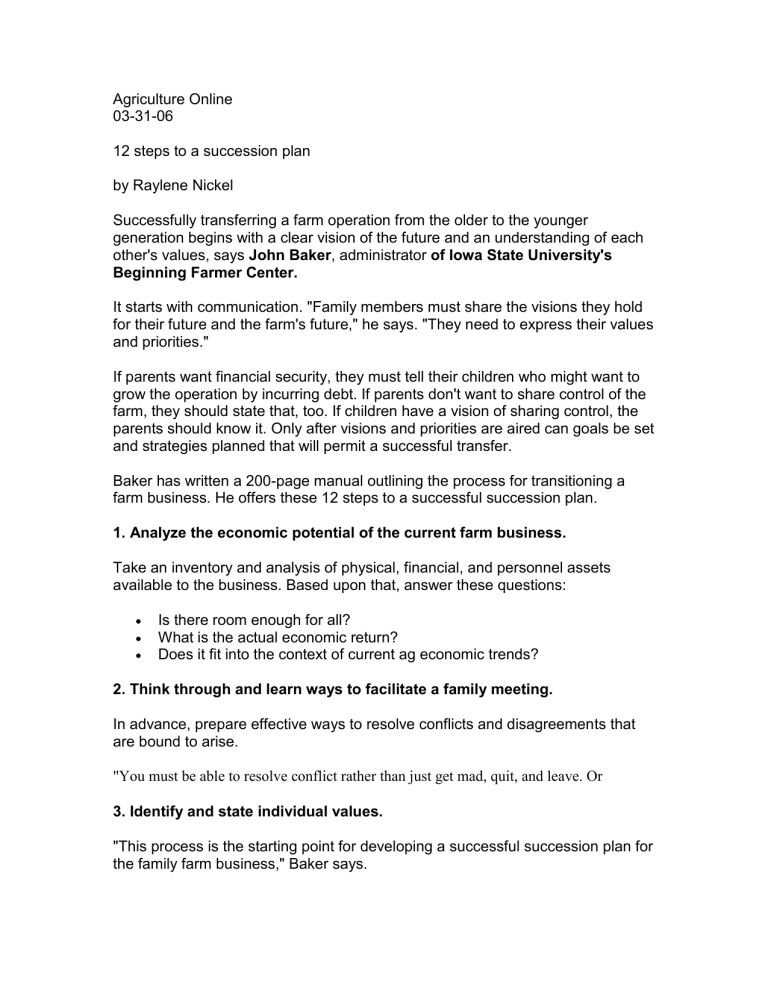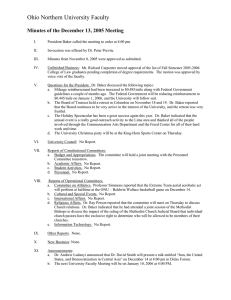Agriculture Online 03-31-06 12 steps to a succession plan

Agriculture Online
03-31-06
12 steps to a succession plan by Raylene Nickel
Successfully transferring a farm operation from the older to the younger generation begins with a clear vision of the future and an understanding of each other's values, says John Baker , administrator of Iowa State University's
Beginning Farmer Center.
It starts with communication. "Family members must share the visions they hold for their future and the farm's future," he says. "They need to express their values and priorities."
If parents want financial security, they must tell their children who might want to grow the operation by incurring debt. If parents don't want to share control of the farm, they should state that, too. If children have a vision of sharing control, the parents should know it. Only after visions and priorities are aired can goals be set and strategies planned that will permit a successful transfer.
Baker has written a 200-page manual outlining the process for transitioning a farm business. He offers these 12 steps to a successful succession plan.
1. Analyze the economic potential of the current farm business.
Take an inventory and analysis of physical, financial, and personnel assets available to the business. Based upon that, answer these questions:
Is there room enough for all?
What is the actual economic return?
Does it fit into the context of current ag economic trends?
2. Think through and learn ways to facilitate a family meeting.
In advance, prepare effective ways to resolve conflicts and disagreements that are bound to arise.
"You must be able to resolve conflict rather than just get mad, quit, and leave. Or
3. Identify and state individual values.
"This process is the starting point for developing a successful succession plan for the family farm business," Baker says.
4. Ask these four questions of each other:
What do you want?
What do you need?
What do you expect?
What do you fear?
"The goal is to have each person share wants, needs, expectations, and fears about the younger party entering the business," he says. "You have to find the courage to ask the questions you've been afraid to ask."
5. Learn to listen.
What are others truly saying to you?
6. Write a vision statement.
Baker encourages each family member to write a statement reflecting a personal vision and one for the family business. The vision statements should refer to a specific time in the future.
7. Write a mission statement for the business.
This statement tells the purpose of the business, including the specific functions it will perform or business needs it will meet. A mission statement should derive from the input of all members of the partnership.
8. Set personal and business goals.
Do you know where you're going?
9. Agree on methods of making management decisions.
"Developing a consistent and known method of decision-making is key to operating a family business and formulating a business succession plan," Baker says.
10. Develop a strategic business plan.
The plan should reflect an internal view of the economic activities of the business and how that economic activity fits within current and futuristic trends of the outside economy.
11. Develop an equitable estate plan.
A comprehensive estate plan provides for transfer of income, management, and assets from the exiting generation to the entering generation. In crafting it, consider the difference between equitable and equal.
Equitable distributions reflect the sweat equity of on-farm heirs. Equal distributions divide properties into shares based on the number of heirs.
"There s nothing more unfair than treating unequals equally," Baker says.
12. Develop a retirement plan.
This should address the financial, recreational, and long-term needs of the retiring generation. "Writing an effective succession plan is a process, not a recipe," Baker says. "Each family business is unique, and its needs change over time. A plan should address those unique needs.
"Having a plan helps create a future based on family priorities and values. It helps to set goals and to develop strategies to achieve those goals," he says



